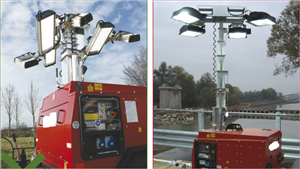

Julien Leblanc:
There will be an ATS installed, which will start the generator, then connect the load.
Yes, one single switch.
Thank you for the reply, is this an existing lighting installation to which you are adding the generator/ATS etc?
And what is the budget for the generator, is it intended for safety purposes, such as lighting for a large crowd to be safe in the event of a mains failure or is it for revenue protection ie to prevent commercial events having to be abandoned due to lighting failure?
AncientMariner:
Since this is for a back-up supply for a sports field, I guess that the main need for lighting will be during a match etc. Is it therefore worth hiring in a mobile generator, once the lights are in situ, to trial both a suitable staged switch on; ie delays between banks being energised and the kVA rating of a suitable generator?
That is what they want, a stationary genset.
mapj1:
If you really cannot avoid dropping all the load on at once, then the genset will need to be over-size by 2 or 3 to reflect that, though in many ways that is just wasteful. If you can drop down to a minimal emergency light level when the ATS kicks over and then bring the bigger load on just a little later it will be better.
Have you got a tame genset supplier ?- the folk who make them are normally more than happy to advise this sort of thing, but as it depends on the build, the 'generic' information covering different internal designs is quite variable.
Yes, all genset suppliers i have contacted told me the same thing: choose a capacity which covers the added inrush currents of all LEDs.
wallywombat:
Of course if the genset is intended to automatically take over, all the light switches may already be physically in the on position; so you wouldn't get the advantage of a staggered power on. Which is another reason for something like time delay relays like Mike suggests.
I was thinking of only one switch, which is connected to a PLC input. The operation of the ATS will result in a PLC reboot and this will start the power on sequence. I'm not yet sure if my logic is ok.
We're about to take you to the IET registration website. Don't worry though, you'll be sent straight back to the community after completing the registration.
Continue to the IET registration site